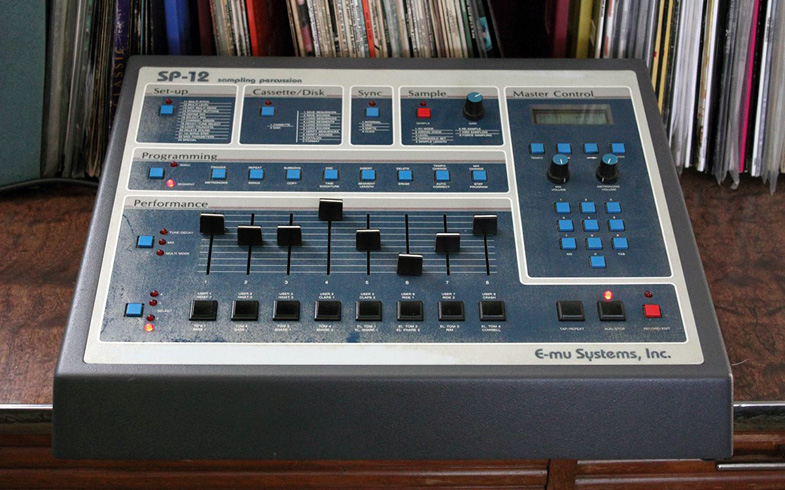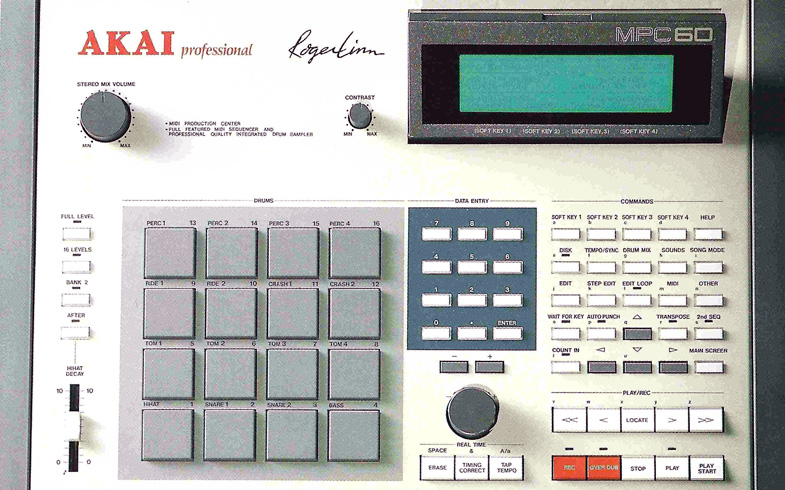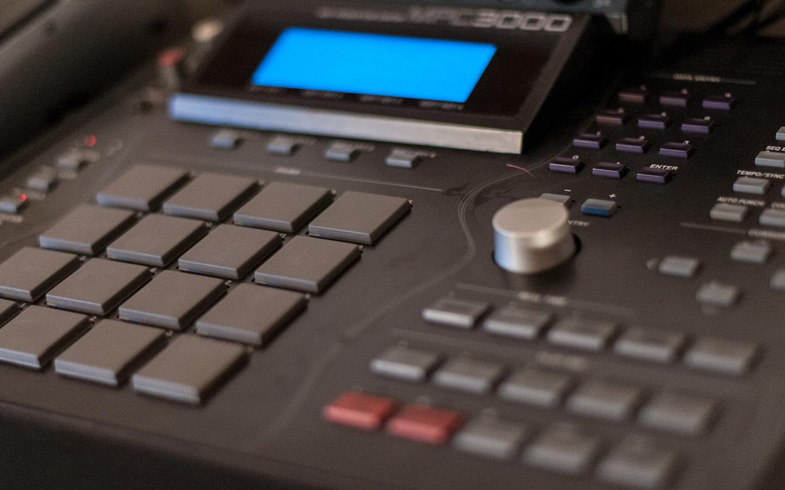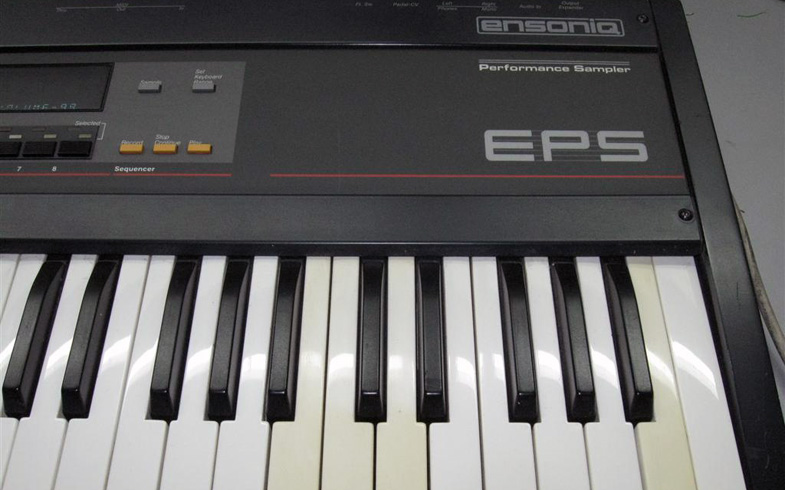E-Mu Systems SP-12 and SP-1200(1985–1998)
One of the first samplers to truly change the face of modern music was E-Mu Systems’ SP–12, which was released in 1985. Conceived as a successor to E-Mu Systems’ Drumulator, a sample-based drum machine originally intended to rival Roger Linn’s iconic LM–1, the SP–12 (Sampling Percussion at 12 bits) included 24 preset drum samples and allowed users to record their own sounds at a crunchy 27.5 kHz sampling rate. When you consider that CD-quality is 44.1 kHz at 16 bit, it’s easy to imagine the “dusty” character that came to characterize the SP–12.
The timing of the SP–12’s arrival on the market was perfect. By 1986 hip-hop was evolving from a perceived fad to a fully-fledged musical revolution and the SP series would play a huge part in shaping the sound of New York rap. A couple of years earlier, Marley Marl had stumbled upon the concept of sampling drum sounds by accident, a technique he would develop on early records with MC Shan. When samplers like the SP–12 appeared, they began to democratise the practice of sampling breakbeats and drum sounds. In the summer of 1986, Rick Rubin was overseeing the sessions for the Beastie Boys’ debut album. On ‘Rhymin & Stealin’ he used the SP–12 to soup up the track’s drums, putting extra weight to the John Bonham samples he’d lifted from Led Zeppelin’s ‘When The Levee Breaks’.
The SP–12 was subverted by the first generation of modern electronic musicians, mirroring how early DJs had repurposed the humble turntable. Once you erased the preset drum sounds, you were free to squeeze as much as you could into the machine’s memory and play the samples in an intuitive, rhythmic manner. Realising what was happening, E-Mu Systems released a Turbo update that expanded the machine’s sampling memory to 5 seconds. Ultimately, though, it would be the SP–12’s successor, the SP–1200, that would unlock sampling’s potential and usher in a golden era of hip-hop beats and dance music classics.
The SP–1200 was released in 1987 and remained in production for a decade. E-Mu Systems played to the machine’s popularity in the nascent hip-hop and dance music worlds by getting rid of the preset drum samples entirely and moving the storage to RAM, which you could fill with a floppy disk. The machine kept the same eight touch pads but added four banks for a total of 32 possible samples. Sampling time was doubled to 10 seconds (which in 1987 was a large amount) and the rate was reduced to 26.04 Khz to accommodate better memory usage. Add to this the SSM2044 filter chips the machines were fitted with and things were about to get crunchy.
The 1200 was one of the first samplers to offer producers, the would-be musicians of a new era, an all-in-one box in which they could create entire tracks. Limitation drives innovation, and the SP series’ weaknesses – scratchy, lo-fi sounds; short sampling time – became strengths. The machine’s easily-identifiable sound became synonymous with much of New York City’s musical output from 1987 onwards.
Akai Music Production Center (MPC) series(1988–)
The MPC 60 launched in 1988 as an all-in-one sampling workstation, followed by the MPC 60-II in 1991. However it was the machine’s next jump, in 1994, that would seal its place in history. The MPC 3000 offered 16-bit, 44.1kHz sampling, vastly increased memory (up to 32MB) and a set of effects and filters. Over the years Akai released additional iterations of the machine including the 2000, 2000XL, 4000, 2500, 1000, 500 and 5000, making it one of the longest running and most comprehensive lines of drum machine samplers. This was largely thanks to the machine’s use in hip-hop and dance music, where it gained cult status throughout the 1990s. In 2012 the MPC series was rebooted with the Renaissance, a sadly sub-par attempt at wresting control back from the likes of Native Instrument’s Maschine, which had arguably superseded the MPC series as the pad-driven sampler of choice for a new generation.
One of the first American hip-hop producers to make use of the MPC 60 was an outsider to the scene: Josh Davis, aka DJ Shadow, who was living in the small town of Davis, California. Speaking to Eliot Wilder for the 33 1/3 book about his groundbreaking debut album Endtroducing, Davis noted that his early single ‘In/Flux’ (which came out on Mo’Wax in 1993) was the first record he produced on the machine. “The MPC wouldn’t really catch on with hip-hop at large for another few years. So, again, I felt lucky on the technological curve, and was doing stuff on the machine before about 95 per cent of producers were.” The majority of his debut album was recorded on the MPC 60 and an ADAT, acting as a proof-of-concept for the machine’s sampling capabilities.
If the E-Mu SP series was the sound of hip-hop in the late 1980s, then the MPC was its equivalent in the following decades. DJ Premier, Hi-Tek and Just Blaze (who in 2006 said he owned the entire series), each responsible for various phases of New York’s hip-hop sound, have all crafted a number of their hit records on the MPC. Prefuse 73 started on an MPC 2000 and moved to the 2000XL, which he used to rethink hip-hop’s aesthetics on his early records. Atlanta’s DJ Toomp, the godfather of trap, ditched the SP–1200 in 1989 in favour of the MPC 60. In Detroit, J Dilla learned to use the MPC at Amp Fiddler’s studio in the Conant Gardens neighbourhood in the early 1990s. Jay Dee’s MPC 3000 became such an integral part of his sound that his machine is set to be included in an addition to the Smithsonian Institution.
While it has remained a studio favourite through the years, the MPC is also a surprisingly rugged machine for live performance. Los Angeles’ Exile is one of the world’s best at manipulating the MPC live, French producer Onra performs with two MPC 1000s, and New York producer AraabMuzik has made quite a career in recent years with his own frantic take on MPC drumming.
It’s fair to say that without the MPC series modern music would sound very different. Sure, someone else would have probably come up with a similar machine, but there’s something about the MPC and how it came about that feels simply irreplaceable. Or as RZA put it: “If there’s ever a hip-hop hall of fame, Roger Linn has to be inducted within the first year. He’s like the motherfucker who made the piano. He’s a genius that should never stop getting props.
Ensoniq EPS, EPS–16+ and ASR–10(1988–1998)
The Ensoniq EPS was an ‘affordable’ keyboard sampler aimed at producers who didn’t want to re-mortgage their homes. Released in 1988, the EPS boasted 13-bit sampling, variable bit rate (from 6.25 to 52kHz) and extendable memory alongside a track sequencer and a set of filters that made it ideal for the growing home studio market and budding bedroom producers. Two years later, Ensoniq doubled up with the EPS–16+, which added 16-bit sampling and editing functions that increased its sampling capabilities.
In New York, a young RZA borrowed an EPS from RNS, Shyheim’s producer, after offering financial help. “RNS left it there about 90 days. Every day I was making beats, all kinds of stuff, then he’s taking it back. Then I got an SP-1200 on some scandal stuff that me and Melquan pulled. ‘Bring the Pain’ was made back then. Then I started getting money. Then I bought the EPS-16+, sticking to the same brand because I was always around the Ensoniq products. I eventually got the ASR. I made the Wu-Tang and Method Man albums with that and a SP–1200.” -RZA
Source: Samplers




